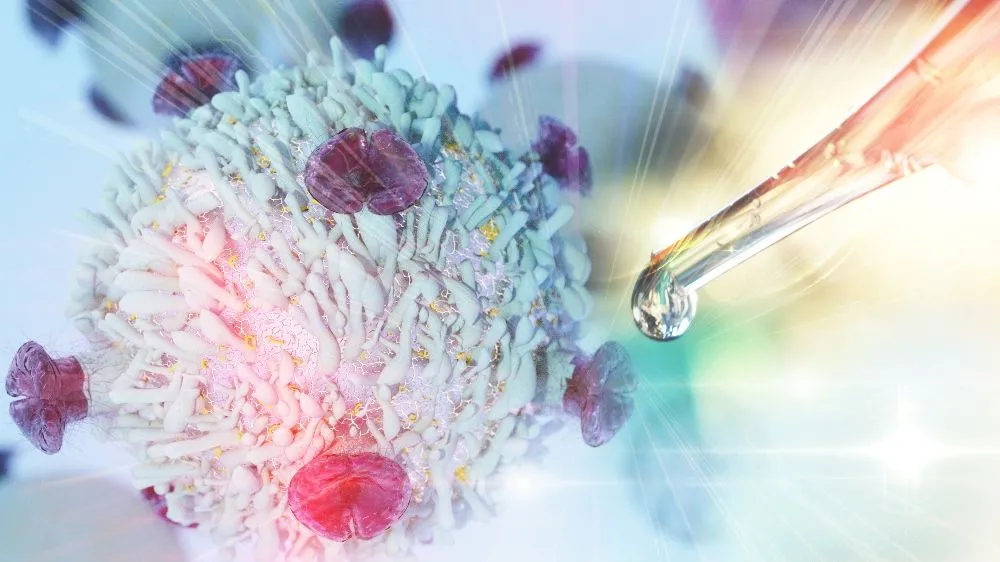Large B-Cell Lymphoma with CNS Involvement: Treatment Options and Future Directions

Diffuse large B-cell lymphoma (DLBCL) is an aggressive type of non-Hodgkin lymphoma (NHL) that can, in some cases, begin in or spread to the central nervous system (CNS). Exactly how or why this happens is not fully understood, but you can read more about the symptoms, types, and prognosis in our previous article: Can DLBCL Spread to the Brain?
Treatment Considerations and Challenges of Treating DLBCL with CNS Involvement
DLBCL involving the CNS can be more difficult to cure, and treatment options can be limited. The type of treatment used may depend on a number of disease- and patient-related factors. Treatment strategies will take into account:
-
Physiological fitness
-
Overall health and functional impairment
-
Brain function
-
Previous therapies received and response to prior therapy
-
Patient choice
One of the main challenges of treating a cancer that has spread to the CNS is the blood-brain barrier. This is a very thin layer that isolates and protects your brain and spinal cord from any harmful substance that might be present in the blood while letting essential nutrients and oxygen pass through. Therefore, your medical team might suggest treatments that can penetrate this barrier and reach the cancer cell to kill it.
The types of treatments that may typically be used include:
-
Radiation therapy
-
Chemotherapy
-
Steroid therapy
-
Targeted therapy
-
High-dose chemotherapy with stem cell transplantation
-
Immunotherapy
Treatment strategies may vary depending on whether the DLBCL started in the CNS (primary) or spread to the CNS (secondary), but you might hear that some of these medications will be administered intrathecally instead of intravenously. Intrathecal administration is a medical procedure where a medication is injected directly into the cerebrospinal fluid (CSF). This fluid surrounds the brain and spinal cord and acts as a protective cushion for your central nervous system. When a medication is administered intrathecally, it bypasses the blood-brain barrier and goes straight to the area where it needs to work.
How is Primary CNS Lymphoma Treated?
The prognosis for primary CNS lymphoma is poor, and the probability of relapse after treatment is high. Whole-brain radiation therapy initially improved outcomes for patients with primary CNS lymphoma; however, lymphoma doctors saw that patients were still relapsing and that the treatment could be too aggressive for the healthy tissue in the brain and the nervous system.
To avoid using whole-brain radiation therapy, chemotherapy is the preferred option for many patients. High-dose methotrexate is typically used due to its ability to penetrate the blood-brain barrier. High-dose methotrexate may be used in combination with other chemotherapeutic agents, such as high-dose cytarabine and thiotepa, and immunotherapies, such as rituximab, to improve the effectiveness of this treatment.
Some patients may be suitable for high-dose chemotherapy followed by autologous stem cell transplantation, which may offer long-term disease control. However, not all patients are eligible for these high-intensity treatments, particularly older patients and patients with more than one disease or condition. Newer treatments are necessary to improve outcomes for these patients.
How is Secondary CNS Lymphoma Treated?
Treating patients with secondary CNS lymphoma is challenging as the treatment must effectively fight the DLBCL throughout the body and also get through the blood-brain barrier.
Due to the poor prognosis associated with secondary CNS lymphoma, treatment often aims to prevent the spread of DLBCL to the CNS in high-risk patients using intrathecal chemotherapy or high-dose methotrexate. The potential benefit of this preventative treatment remains an area of ongoing research.
A dose-intensive chemotherapy regimen similar to regimens used in primary CNS lymphoma with autologous stem cell transplantation is used in some cases, but many patients are ineligible for this treatment. Overall, treatment options for secondary CNS lymphoma are limited.
Future Directions
Innovative approaches are being developed that may improve outcomes for patients with DLBCL and CNS involvement.
As the genetic profile of DLBCL is similar to primary CNS lymphoma and subsets of secondary CNS lymphoma, targeted therapies, such as the BTK inhibitor ibrutinib, may be used in combination with chemotherapy regimens to improve outcomes.
Immunomodulatory agents, such as lenalidomide and pomalidomide, can be used in combination with other agents. Immune checkpoint inhibitors and chimeric antigen receptor (CAR) T cells also have the potential to improve outcomes, although these are in the earlier stages of development for CNS lymphoma.
Can Patients with DLBCL and CNS Involvement Participate in Clinical Trials?
While some patients may be eligible to participate in clinical trials, unfortunately, trials testing new approaches often exclude patients with DLBCL with CNS involvement. Understanding the eligibility criteria for each trial is essential. Your doctor can help you determine if you're a good candidate for a particular trial.
Talking to your doctor about clinical trial options could be a game-changer. Clinical trials offer access to cutting-edge treatments and the chance to contribute to medical advancements.
Ready to explore your options? Visit the HealthTree Clinical Trial Finder to see currently open trials. Discover new possibilities and treatment alternatives:
HealthTree Clinical Trial Finder
Key takeaways
-
DLBCL with CNS involvement can be challenging to treat, with limited options available.
-
Typically, treatment consists of high-dose chemotherapy with methotrexate, which can penetrate the blood-brain barrier.
-
Newer approaches with targeted therapies, immunomodulatory agents, and immunotherapies may improve outcomes.
-
Clinical trials may exclude patients with DLBCL and CNS involvement, depending on the eligibility criteria.
Sources:
Diffuse large B-cell lymphoma (DLBCL) is an aggressive type of non-Hodgkin lymphoma (NHL) that can, in some cases, begin in or spread to the central nervous system (CNS). Exactly how or why this happens is not fully understood, but you can read more about the symptoms, types, and prognosis in our previous article: Can DLBCL Spread to the Brain?
Treatment Considerations and Challenges of Treating DLBCL with CNS Involvement
DLBCL involving the CNS can be more difficult to cure, and treatment options can be limited. The type of treatment used may depend on a number of disease- and patient-related factors. Treatment strategies will take into account:
-
Physiological fitness
-
Overall health and functional impairment
-
Brain function
-
Previous therapies received and response to prior therapy
-
Patient choice
One of the main challenges of treating a cancer that has spread to the CNS is the blood-brain barrier. This is a very thin layer that isolates and protects your brain and spinal cord from any harmful substance that might be present in the blood while letting essential nutrients and oxygen pass through. Therefore, your medical team might suggest treatments that can penetrate this barrier and reach the cancer cell to kill it.
The types of treatments that may typically be used include:
-
Radiation therapy
-
Chemotherapy
-
Steroid therapy
-
Targeted therapy
-
High-dose chemotherapy with stem cell transplantation
-
Immunotherapy
Treatment strategies may vary depending on whether the DLBCL started in the CNS (primary) or spread to the CNS (secondary), but you might hear that some of these medications will be administered intrathecally instead of intravenously. Intrathecal administration is a medical procedure where a medication is injected directly into the cerebrospinal fluid (CSF). This fluid surrounds the brain and spinal cord and acts as a protective cushion for your central nervous system. When a medication is administered intrathecally, it bypasses the blood-brain barrier and goes straight to the area where it needs to work.
How is Primary CNS Lymphoma Treated?
The prognosis for primary CNS lymphoma is poor, and the probability of relapse after treatment is high. Whole-brain radiation therapy initially improved outcomes for patients with primary CNS lymphoma; however, lymphoma doctors saw that patients were still relapsing and that the treatment could be too aggressive for the healthy tissue in the brain and the nervous system.
To avoid using whole-brain radiation therapy, chemotherapy is the preferred option for many patients. High-dose methotrexate is typically used due to its ability to penetrate the blood-brain barrier. High-dose methotrexate may be used in combination with other chemotherapeutic agents, such as high-dose cytarabine and thiotepa, and immunotherapies, such as rituximab, to improve the effectiveness of this treatment.
Some patients may be suitable for high-dose chemotherapy followed by autologous stem cell transplantation, which may offer long-term disease control. However, not all patients are eligible for these high-intensity treatments, particularly older patients and patients with more than one disease or condition. Newer treatments are necessary to improve outcomes for these patients.
How is Secondary CNS Lymphoma Treated?
Treating patients with secondary CNS lymphoma is challenging as the treatment must effectively fight the DLBCL throughout the body and also get through the blood-brain barrier.
Due to the poor prognosis associated with secondary CNS lymphoma, treatment often aims to prevent the spread of DLBCL to the CNS in high-risk patients using intrathecal chemotherapy or high-dose methotrexate. The potential benefit of this preventative treatment remains an area of ongoing research.
A dose-intensive chemotherapy regimen similar to regimens used in primary CNS lymphoma with autologous stem cell transplantation is used in some cases, but many patients are ineligible for this treatment. Overall, treatment options for secondary CNS lymphoma are limited.
Future Directions
Innovative approaches are being developed that may improve outcomes for patients with DLBCL and CNS involvement.
As the genetic profile of DLBCL is similar to primary CNS lymphoma and subsets of secondary CNS lymphoma, targeted therapies, such as the BTK inhibitor ibrutinib, may be used in combination with chemotherapy regimens to improve outcomes.
Immunomodulatory agents, such as lenalidomide and pomalidomide, can be used in combination with other agents. Immune checkpoint inhibitors and chimeric antigen receptor (CAR) T cells also have the potential to improve outcomes, although these are in the earlier stages of development for CNS lymphoma.
Can Patients with DLBCL and CNS Involvement Participate in Clinical Trials?
While some patients may be eligible to participate in clinical trials, unfortunately, trials testing new approaches often exclude patients with DLBCL with CNS involvement. Understanding the eligibility criteria for each trial is essential. Your doctor can help you determine if you're a good candidate for a particular trial.
Talking to your doctor about clinical trial options could be a game-changer. Clinical trials offer access to cutting-edge treatments and the chance to contribute to medical advancements.
Ready to explore your options? Visit the HealthTree Clinical Trial Finder to see currently open trials. Discover new possibilities and treatment alternatives:
HealthTree Clinical Trial Finder
Key takeaways
-
DLBCL with CNS involvement can be challenging to treat, with limited options available.
-
Typically, treatment consists of high-dose chemotherapy with methotrexate, which can penetrate the blood-brain barrier.
-
Newer approaches with targeted therapies, immunomodulatory agents, and immunotherapies may improve outcomes.
-
Clinical trials may exclude patients with DLBCL and CNS involvement, depending on the eligibility criteria.
Sources:

about the author
Dylan Barrett
Dylan is a freelance medical writer based in Cork, Ireland. He previously worked in independent medical education while living in London and is now collaborating with HealthTree to develop resources for blood cancer patients. His background is in genetics, and he has a passion for innovative scientific research. In his spare time, he enjoys sports, traveling, and spending time with his family and friends.
More on Treatment Advances
Your Source for Expert Insights & Support in Lymphoma.
By subscribing to the Healthtree newsletter, you'll receive the latest research, treatment updates, and expert insights to help you navigate your health.
Thanks to our HealthTree Community for Lymphoma Sponsors:















